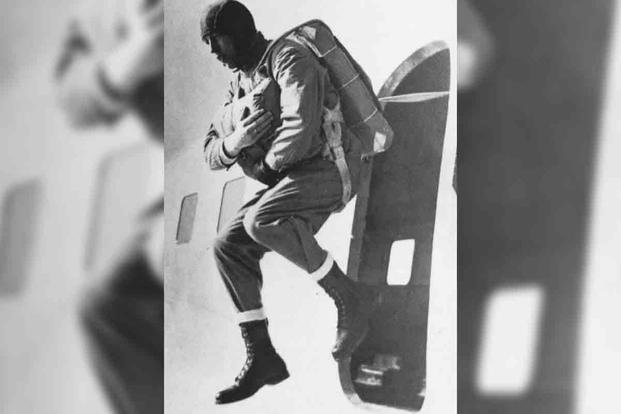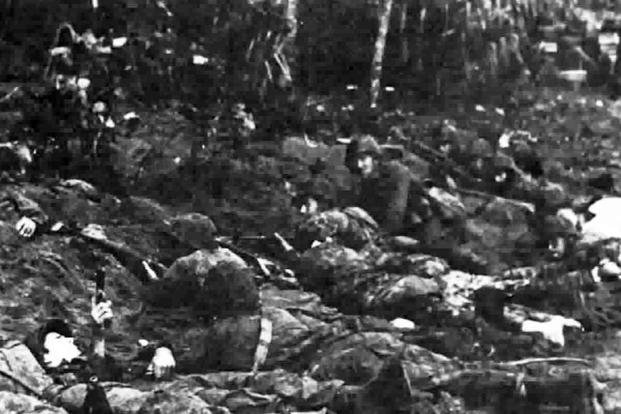The U.S. Army might have perfected the use of airborne troopers, but it wasn't the first branch to try out the tactic. In 1927, 12 Marines jumped from a transport plane flying over the Anacostia area of Washington, D.C. The Army wouldn't begin experimenting with jumping out of a perfectly good airplane until the next year.
Since that first jump, the Marine Corps liked the idea of "air-delivered" Marines, but never tried to train any until Nazi Germany invaded the Netherlands in 1940. Germany's use of paratroopers to capture airfields and other tactical objectives was one of the world's first mass drops. A total of 4,500 paratroopers opened the way for Germany to conquer Holland and the Low Countries in a matter of days.
Its success spurred Commandant of the Marine Corps Maj. Gen. Thomas Holcomb to order the Corps to start developing paratroopers immediately. It would result in the short-lived 1st Marine Parachute Regiment, which came to be known as "Paramarines."
Paramarines had three specific missions. The first was a recon and raiding force, even if their ability to return to friendly lines was limited. The second was acting as an advance guard to seize important objectives, such as airfields or terrain. Their third role was acting as a guerrilla force for extended periods of time.

The Marine Corps' 16-week parachute school was not easy; it had a 40% washout rate. Marines were quick to volunteer despite the strict prerequisites and the rigorous training. Marines had to be unmarried, 21-32 years old, high school graduates, interested in physical fitness and have no physical or mental impairments. The Marines were trying something entirely new and needed the best.
In what is perhaps a tribute to the Marine Corps mentality (or the extra $50 in their paychecks), so many Marines applied to be Paramarines that multiple parachute schools had to be established. 1941 might have begun with just a handful of graduates, but they soon had enough to form the 1st Parachute Battalion.
It left for the Pacific Theater in June 1942, arriving in New Zealand the next month and immediately left for Fiji to begin rehearsing the upcoming invasion of Guadalcanal. They weren't being dropped, however. The Marines had no transport aircraft for that. In fact, they never did. The Marine Corps never conducted a combat jump in World War II.
So when the invasion of Guadalcanal came, the unit conducted an amphibious assault on Gavutu and, later, Tanambogo. Though highly trained, the parachutists had never trained for a seaborne landing and had no mortars, machine guns or heavy weapons. Thankfully, the Japanese put up little resistance on Gavutu at first.
By the time the enemy recovered from the surprise, it was too late. Paramarines occupied Gavutu before nightfall. Its sister island of Tanambogo was another story. Connected by a causeway, it would take the Marines another two days and 20% casualties to secure both islands.
On Sept. 8, the 1st Parachute Battalion joined up with the 1st Raider Battalion, because both had been badly reduced by casualties and disease. They soon found themselves on Guadalcanal, in position on a ridge near Henderson Field, fighting for their lives against an overwhelming enemy in a brutal fight that would become known as the Battle of Bloody Ridge.
The fight cost the 1st Raiders 135 men and the 1st Parachute Battalion 128 men. Of those totals, 59 were dead or missing, including 15 parachutists killed. Paramarines took so many casualties, they had to be withdrawn, sick and wounded, to Camp Kiser in New Caledonia after the battle.
By March 1943, the 2nd and 3rd Parachute Battalions arrived at Camp Kiser. They were finally together as the 1st Parachute Regiment, part of the I Marine Amphibious Corps. But by this time, the Corps was reconsidering the need for paratroopers. They were expensive, took a lot of manpower to train and required all Marine Corps transport craft in theater to drop just half the regiment. Four combat jumps were planned, but never executed.
That doesn't mean they sat out the war. The 2nd Battalion assaulted the island of Choiseul on Oct. 30, 1943, as a diversion to keep the Japanese from mounting an effective resistance against the Americans' next landing. The Bougainville Campaign began two days later.

By Dec. 3, the entire parachute regiment was fighting on Bougainville, supporting the 2nd Raider regiment and 1st Battalion, 3d Marines, in its last combat action of the war. In just a few weeks, they were all headed back to San Diego, to be reorganized. The regiment was disbanded in February 1944.
-- Blake Stilwell can be reached at blake.stilwell@military.com. He can also be found on Twitter @blakestilwell or on LinkedIn.
Want to Learn More About Military Life?
Whether you're thinking of joining the military, looking for post-military careers or keeping up with military life and benefits, Military.com has you covered. Subscribe to Military.com to have military news, updates and resources delivered directly to your inbox.
















